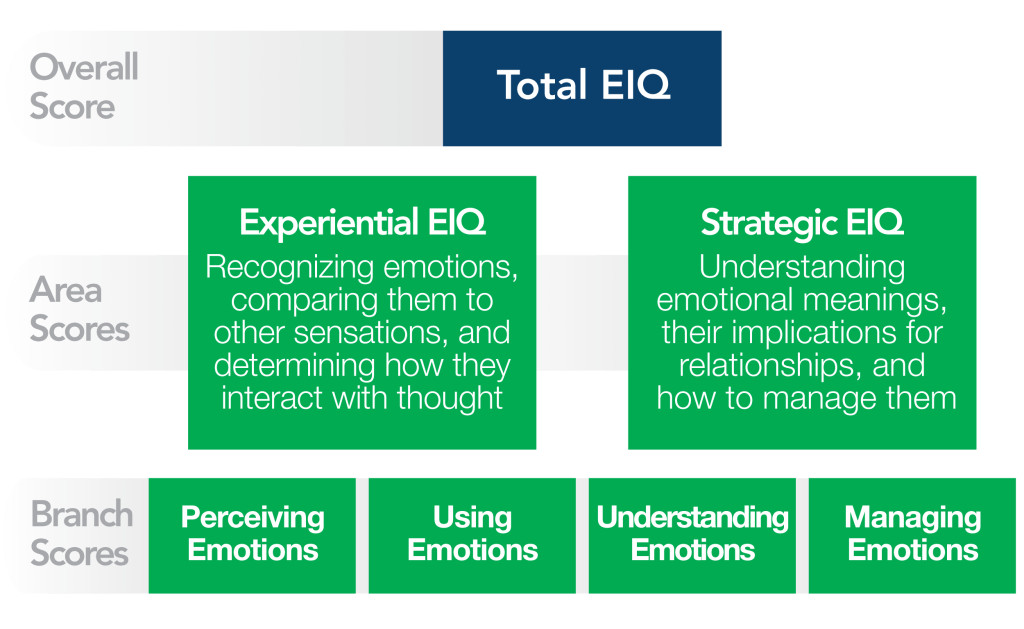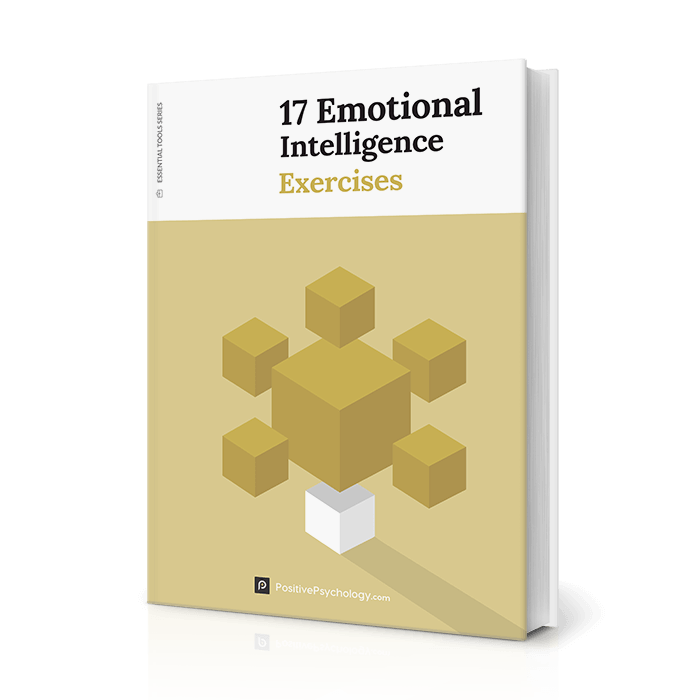Emotional Intelligence Skills and How to Develop Them
 While it’s only become a more popular buzzword in the past decade, the concept of emotional intelligence skills has been around for at least 25 years.
While it’s only become a more popular buzzword in the past decade, the concept of emotional intelligence skills has been around for at least 25 years.
Whether you know it as emotional quotient (EQ), emotional intelligence (EI), or you’re familiar with the idea of “soft skills” more broadly, emotional intelIigence plays an important role in our daily lives.
Emotional intelligence underpins our professional relationships, interpersonal communications, and ability to motivate ourselves.
If you’ve ever held yourself back when you’ve felt like lashing out, you’re already familiar with one way EI works. Like other aspects of the self, it’s not tangible, but even though we can’t see emotional intelligence, we can certainly feel its impact.
Before you read on, we thought you might like to download our three Emotional Intelligence Exercises for free. These science-based exercises will not only enhance your ability to understand and work with your emotions but will also give you the tools to foster the emotional intelligence of your clients, students, or employees.
This Article Contains:
- What Are Emotional Intelligence Skills?
- Real-Life Examples of Emotional Intelligence
- Emotional Intelligence, Social Skills, and You
- How to Develop Emotional Intelligence Skills
- Emotional Intelligence Skills Assessment
- 3 Exercises to Develop EI Skills
- Great TEDx Talks and YouTube Videos
- A Take-Home Message
- References
What are Emotional Intelligence Skills?
Emotional intelligence is:
“a type of intelligence that involves the ability to process emotional information and use it in reasoning and other cognitive activities.”
American Psychological Association, 2018
EI is relevant in both our professional and personal relationships, as well as the relationships we have with ourselves. We’ll look at the dynamics of how EI plays a big role in interpersonal skills.
“Emotional intelligence” was coined by two American psychologists, John Mayer and Peter Salovey, in 1997, and from their definition, we can get a great idea of what emotional intelligence skills are all about:
“The emotionally intelligent person is skilled in four areas: identifying emotions, using emotions, understanding emotions, and regulating emotions.”
Emotional intelligence is at play throughout our everyday lives (Schutte et al., 2001):
- EI helps us manage our emotions by allowing us to dismiss, ignore, or regulate our unproductive emotions in instances when they’re just not helpful. For example, there’s little value in yelling at a bus driver because your commute has been slowed down by bad traffic.
- Our EI abilities are what allow us to notice and understand how others are feeling. They play a big role in defining who we are by shaping our relationships with others around us.
- Our emotional intelligence skills are believed to be huge contributors to our overall success in life, due to their influence on our ability to self-manage and motivate.
Real-Life Examples of Emotional Intelligence

We’ll use workplace examples and also consider how EI looks in personal relationships.
Listening to others
Jane works at an advertising agency, and things can get a little hectic during the brainstorming process. Everyone struggles to get their opinion heard, thinking they have the best idea. Quite often, this leads to a lot of raised voices. When Jane’s college Bob presents a campaign idea, it’s difficult for him to get his point across without another team member talking over him, which demonstrates very little respect and can lead to hurt feelings.
Before the next meeting, Jane calmly suggests that people listen quietly to one another when other’s are presenting. With this simple request, Jane is demonstrating strong emotional intelligence. Specifically, she’s perceiving that Bob is feeling disrespected and she’s attempting to manage emotions in the room. Both recognition and effective handling of the team’s emotions are at play.
When everyone starts to listen to one another, per Jane’s suggestion, it’s much simpler to reach a constructive decision together.
Facilitating thought
Daniel is a parking inspector, and this means that sometimes people return to their cars to find him printing out a ticket. Over the years, he’s learned that an authoritative, “only doing my job” attitude tends to provoke negative reactions from drivers. Often, these lead to complaints about his performance.
When drivers catch Daniel printing out a ticket, he now starts their interaction with a smile. He asks how they’re doing and then starts a chat about the weather. By detecting and attending to their emotions, then adapting his communication strategy using higher-level mental processes, he’s managed to reduce the complaints against him by 90%. He’s also successfully managed others’ emotions despite their potentially irrational behavior.
Understanding others’ perspectives
Lisa has gone over to Debby’s house to return a dress she borrowed. She even brings a slice of cake because she knows that Debby has had a very stressful week at work. Debby’s in an unpleasant mood because she’s exhausted and doesn’t invite Lisa inside. Instead, she is snappy and closes the door on her friend as soon as she can. Lisa is upset, thinking “How horrible” as she walks home.
During the walk, Lisa reflects on the situation and takes a moment to think about Debby, who has been busy with incredibly long hours, working until 9 pm each day at the office. She dismisses her earlier thoughts and recognizes that Debby has just been tired and a little worn out. By putting herself in her friend’s shoes and looking at the emotional situation objectively, she’s been able to make a rational decision about how to react.
Rather than getting angry at Debby, she decides to give her a friendly call later in the week to let her know she hopes things have become less hectic.
Emotional Intelligence, Social Skills, and You
As the above examples illustrate, emotional intelligence, social skills, and communication skills are inextricably linked.
Being aware of our emotions and handling our feelings can be critical in determining success in many aspects of life (Bar-On, 2006, 2013). Unsurprisingly, relationships, emotional intelligence, and social skills play a huge role in our happiness and family relationships (Gottman et al., 1998).
When it comes to EI skills, the ability to perceive and manage emotions helps us cope with conflict. It does this by allowing us to anticipate how others are feeling and adapt our responses so we can resolve them in a mutually beneficial way.
Interestingly, academics have noted a specific positive linkage between EI and increased relationship satisfaction (Malouff et al., 2014). And this has made it possible for us to develop actionable strategies to improve our relationships by growing our emotional intelligence skills. Here are some examples of how we can do this.
How to Develop Emotional Intelligence Skills

1. Work on your self-awareness
Mindfulness is key with this exercise, which is surprisingly easy. Start by simply taking a little time to think about your reactions to daily events. A few quiet moments at the end of the day are perfect for reflecting on what happened to you and how you felt. Corporate psychologist Dr. Patricia Thompson (2018) suggests not to stop here, either.
She stresses that it’s important to take this reflection a little further by spending some time considering your own strengths, triggers, values, and opportunities that you see to develop further (Thompson, 2018). This EI exercise is built on Mayer and Salovey’s (1997) concept of perceiving emotions—it starts with you!
2. Reframe your perception of self-management
Executive coach Roger Reece (2018) advises that conflicts with others can often be problems that relate to our frame of reference. As an example, reframing is what we do when we switch from a glass-half-empty to a glass-half-full perspective, in a sense. When developing our EI, we take this internal process and apply it to our interactions with others. Here’s Reece’s (2018) description of how it works:
“By reframing conflict with a co-worker as an opportunity to build better teamwork with that person, you can find the motivation to initiate a conversation rather than avoid the conflict as unworkable. During a difficult conversation, you can reframe the way you see the other person – not as an enemy, but rather a potential new ally.”
The concept of reframing is a popular one with EI practitioners and works well if you are looking for a long-term way to deal with unavoidable interpersonal conflicts. As an example, imagine that someone is criticizing an idea you have come up with. Now imagine reframing the situation: “How useful these suggestions are, I can use them to improve my idea.”
3. Become aware of your emotional triggers
Another approach Reece (2018) suggests for learning to manage our own emotions is to identify the triggers that set them off in the first place. This involves trying to isolate, anticipate, and control the aspects of our interactions with others that set us off.
A common example is what Reece calls the offense trigger. It describes most people’s tendency to become offended by others’ body language, tone of voice, etc. during arguments. The opposite is considering what their intended message might actually be; maybe they’re just trying to help.
We’ve included a really great exercise on identifying your triggers in one of the worksheets below. The underpinning motivation for identifying our triggers is to be able to control our maladaptive emotional responses to them. If we know that someone’s tendency to speak frankly tends to set us off, for example, we can adapt our behaviors accordingly when we interact with them.
Being less defensive and aggressive if an interaction is unavoidable, for example, can help us reach a constructive conclusion when we engage.
4. Recognize and celebrate your positive emotions
This practice is as simple as taking the time to do things that make you experience positive emotions. This isn’t about taking a tropical vacation each weekend. It’s more about intentionally engaging in intrinsically rewarding activities like being kind, recalling past happy memories, and expressing our gratitude when we interact with others (Thompson, 2018).
This exercise is based on the idea that experiencing more positive emotions puts you in a better and more resilient position when negative things occur. We’re better equipped, in this respect, by taking conscious steps to celebrate the things that evoke positive feelings in ourselves.
Emotional Intelligence Skills Assessment
While many different organizations and practitioners use varying emotional intelligence skills assessments, the best known is probably the Mayer-Salovey-Caruso Emotional Intelligence Test (Mayer et al., 2002).
Mayer-Salovey-Caruso Emotional Intelligence Test
The Mayer-Salovey-Caruso Emotional Intelligence Test (MSCEIT) uses a whopping 141 items to measure four emotional intelligence skills mentioned above. It also gives you area scores for Experiential EI and Strategic EI and one total EI score, as the picture below shows (Brackett & Salovey, 2006).

Some example questions are shown below (Mayer et al., 2002; Price & Walle, 2018):
1. Identifying emotions
| Indicate the emotions expressed by this face. | |||||
|---|---|---|---|---|---|
| Happiness | 1 | 2 | 3 | 4 | 5 |
| Fear | 1 | 2 | 3 | 4 | 5 |
| Sadness | 1 | 2 | 3 | 4 | 5 |
2. Using emotions
What mood(s) might be helpful to feel when meeting in-laws for the very first time?
| Not useful | Useful | ||||
|---|---|---|---|---|---|
| Tension | 1 | 2 | 3 | 4 | 5 |
| Surprise | 1 | 2 | 3 | 4 | 5 |
| Joy | 1 | 2 | 3 | 4 | 5 |
3. Understanding emotions
Tom felt anxious and became a bit stressed when he thought about all the work he needed to do. When his supervisor brought him an additional project, he felt ____. (Select the best choice.)
- Overwhelmed
- Depressed
- Ashamed
- Self-conscious
- Jittery
4. Managing Emotions
Angie just returned from vacation. She was feeling peaceful and content. On a scale of one to five, how well would each action preserve her mood?
Action 1: She started to make a list of things at home that she needed to do.
Very ineffective..1…..2…..3…..4…..5..Very effective
Action 2: She began thinking about where and when she would go on her next vacation.
Very ineffective..1…..2…..3…..4…..5..Very effective
Action 3: She decided it was best to ignore the feeling since it wouldn’t last anyway.
Very ineffective..1…..2…..3…..4…..5..Very effective
You can learn more about the full version of the MSCEIT here.
The Harvard Business Review EI Assessment
This emotional intelligence test is much shorter, comprising only 25 items, which you can do here (McKee, 2015). Because the answers are all on the same five-point Likert scale, the test is easy to complete. Here are some sample items (not in the original order):
1) I can describe my feelings in detail, beyond just “happy,” “sad,” “angry,” and so on.
- Always
- Most of the time
- Frequently
- Sometimes
- Rarely
- Never
2) I focus on opportunities rather than obstacles.
- Always
- Most of the time
- Frequently
- Sometimes
- Rarely
- Never
3) I see people as good and well intentioned.
4) I use strong emotions, such as anger, fear, and joy, appropriately and for the good of others.
5) I readily understand others’ viewpoints, even when they are different from my own.
6) My curiosity about others drives me to listen attentively to them.
7) I adapt easily when a situation is uncertain or ever-changing.
On the HBR website itself, you can submit your answers online, and even ask others to respond to the same test while thinking about you.
3 Exercises to Develop EI Skills
Developing your emotional intelligence skills doesn’t have to be difficult. Whether you prefer to learn from books, exercises, or videos, there’s something for everyone.
The important thing is to find what works for you, as you’ll quickly discover that this makes it much easier to continue the great work over time.
Perceiving, understanding, and managing emotions
This exercise is for everyone. You’ll note that a lot of emotional intelligence exercises are based on reflection. Whether it’s a reflection on your own experiences, your interactions with others, or part of a longer, ongoing journaling exercise, reflection and EI often go hand in hand.
The exercise starts with recalling a recent occasion when something unexpected occurred and caused you to feel certain emotions.
Think about:
- The people who were there.
- What happened.
- The emotions you felt.
- The emotions you presently feel as you recall and reflect on the event.
Note down your reflections in answer to the following questions:
- What did you first become aware of, in yourself, as you remembered the situation?
- What physical sensations did you notice?
- How would you describe the first emotion you felt as you remembered this experience?
- When did you become aware of the emotion? (both during the situation itself and during the process of remembering)
- What signals alerted you that this was the emotion you were experiencing?
- What triggered this particular emotion for you?
This exercise is part of an Emotional Intelligence Skills eBook from The Myers-Briggs Company.
Understanding triggers
The exercise above gave an in-depth look at how we can perceive emotions in response to a certain event. The Therapist Aid’s (2017) Understanding Triggers worksheet starts by identifying unwanted emotional responses (anger, frustration, jealousy, etc.) and helps us work on strategies. It can be used to better understand potentially maladaptive coping mechanisms.
A trigger is “a stimulus – such as a person, place, situation, or thing – that contributes to an unwanted emotional or behavioral response” (Therapist Aid, 2017).
We start by identifying the problem: something that our unwanted responses are contributing to. Maybe it’s snapping at others in the workplace or reacting badly to negative feedback.
Describe the problem your triggers are contributing to. What’s the worst-case scenario if you are exposed to your triggers?
We then explore these by sorting them into trigger categories. We think about each of the six categories below and ask ourselves if any of these trigger the unwanted emotional response:
- Emotional state
- People
- Place
- Things
- Thoughts
- Activities
- Situations
Ideally, we start to identify our triggers and avoid them where possible. This step makes it easier for us to then fill out the following table, which is adapted from the original exercise (Therapist Aid, 2017):
| Trigger one | Trigger two | Trigger three | |
|---|---|---|---|
| List your three biggest triggers in detail | |||
| Describe a strategy for avoiding or reducing exposure to each trigger | |||
| Describe your strategy for dealing with each trigger head on, when they cannot be avoided |
Avoiding unnecessary triggers and learning to better handle those that are just part of life are also welcome ways to cut down on stress.
Self-Management Activity
This self-management activity looks at how to better manage our own behavioral reactions to the emotions we feel. Sometimes it’s natural to feel really angry – traffic jams come instantly to mind!
There are two super-simple steps to this activity. In the first, think back to a time you felt angry, and list your reactions and behaviors in response to the following statement:
The last time I was angry, I…
For the second activity, describe some healthy management skills and behaviors. These are how you’d prefer to react to similar situations in the future. Some suggestions of healthy management skills include:
- Breathing deeply
- Going for a walk
- Taking a break
- Taking a shower
- Lying down
- Thinking before you speak
- Distracting yourself
- Writing about it
Great TEDx Talks and YouTube Videos
If you’re a different kind of visual learner, we recommend you find out more about emotional intelligence, social skills, and communication skills from some of these videos:
The Power of Emotional Intelligence
A TEDx talk by Travis Bradberry, who gives some great examples to answer the question “What are emotional intelligence skills?”
Daniel Goleman Introduces Emotional Intelligence
A short, concise, but informative video from Daniel Goleman, the journalist and psychologist who helped to popularize the EI concept.
Emotional Intelligence: From Theory to Everyday Practice
An interesting one from Yale University, looking at emotional intelligence abilities in everyday life.
Emotional Intelligence: How Good Leaders Become Great
From the UC Davis Executive Leadership Program, this talk also considers emotional intelligence and coaching skills for leaders.
A Take-Home Message
In this article, we’ve considered several approaches to defining emotional intelligence and how we can start to develop our own EI skills through activities and mindfulness. We’ve looked at the many ways that emotional intelligence, social skills, and communication are all related to hopefully give you an idea of how EI can:
- Improve your relationship satisfaction
- Help you understand and manage your own emotions
- Make you more successful at dealing with everyday frustrations
- Help you work toward more mutually beneficial resolutions to conflict
- Get you through those traffic jams without pulling your hair out!
Do you have great quotes or mental techniques for developing your emotional intelligence skills? Have you found a great approach that works for you? If so, we are keen for you to share your thoughts with us.
We hope you enjoyed reading this article. Don’t forget to download our three Emotional Intelligence Exercises for free.
- American Psychological Association. (n.d.). Emotional intelligence, In APA Dictionary of Psychology. Retrieved from https://dictionary.apa.org/emotional-intelligence.
- Bar-On, R. (2006). The Bar-On model of emotional-social intelligence (ESI). Psicothema, 18(S),13-25.
- Bar-On, R. (2013). Theoretical foundations, background and development of the Bar-On model of emotional intelligence. Retrieved from http://www.reuvenbaron.org/wp/theoretical-foundations-background-and-development-of-the-bar-on-model-of-emotional-intelligence/
- Brackett, M. A., & Salovey, P. (2006). Measuring emotional intelligence with the Mayer-Salovey-Caruso Emotional Intelligence Test (MSCEIT). Psicothema, 18(S), 34-41.
- Gottman, J. M., Coan, J., Carrere, S., & Swanson, C. (1998). Predicting marital happiness and stability from newlywed interactions. Journal of Marriage and the Family, 60(1), 5–22.
- Malouff, J. M., Schutte, N. S., & Thorsteinsson, E. B. (2014). Trait emotional intelligence and romantic relationship satisfaction: A meta-analysis. The American Journal of Family Therapy, 42(1), 53-66.
- Mayer, J., & Salovey, P. (1997). What is Emotional Intelligence? In P. Salovey and D. Sluyter (Eds). Emotional Development and Emotional Intelligence. New York: Basic Books.
- Mayer, J. D., Salovey, P., & Caruso, D. (2002). Mayer-Salovey-Caruso Emotional Intelligence Test manual. Toronto: Multi-Health Systems.
- McKee, A. (2015, June 5). Quiz yourself: Do you lead with emotional intelligence? Harvard Business Review. Retrieved from https://hbr.org/2015/06/quiz-yourself-do-you-lead-with-emotional-intelligence
- Price, C., & Walle, E. (Eds.) (2018). Emotion researcher: ISRE’s sourcebook for research on emotion and affect. International Society for Research on Emotion. Retrieved from http://emotionresearcher.com/wp-content/uploads/2018/03/Emotion-Researcher-March-2018.pdf
- Reece, R. (2018). Emotional Intelligence & Conflict Management. Retrieved from http://emotionalintelligenceworkshops.com/emotional-intelligence-conflict-management.htm
- Schutte, N. S., Malouff, J. M., Bobik, C., Coston, T. D., Greeson, C., Jedlicka, C., & Wendorf, G. (2001). Emotional intelligence and interpersonal relations. The Journal of social psychology, 141(4), 523-536.
- Therapist Aid. (2017). Triggers. Retrieved from https://www.therapistaid.com/worksheets/triggers/
- Thompson, P. (2018). 9 Tips To Increase Your Emotional Intelligence For Stronger Relationships. Retrieved from https://www.mindbodygreen.com/0-17573/9-tips-to-increase-your-emotional-intelligence-for-stronger-relationships.html.
Let us know your thoughts
Read other articles by their category
- Body & Brain (49)
- Coaching & Application (57)
- Compassion (26)
- Counseling (51)
- Emotional Intelligence (24)
- Gratitude (18)
- Grief & Bereavement (21)
- Happiness & SWB (40)
- Meaning & Values (26)
- Meditation (20)
- Mindfulness (45)
- Motivation & Goals (45)
- Optimism & Mindset (34)
- Positive CBT (28)
- Positive Communication (20)
- Positive Education (47)
- Positive Emotions (32)
- Positive Leadership (18)
- Positive Parenting (4)
- Positive Psychology (33)
- Positive Workplace (37)
- Productivity (16)
- Relationships (46)
- Resilience & Coping (36)
- Self Awareness (21)
- Self Esteem (38)
- Strengths & Virtues (31)
- Stress & Burnout Prevention (34)
- Theory & Books (46)
- Therapy Exercises (37)
- Types of Therapy (64)






What our readers think
great conversations about emotional intelligence
This was a great course, i will take this again. a reminder to control emotions
Any thoughts on helping a pre teen develop stronger EI? Possibly books or activities specific for that age group. Modeling behaviors/ trying to talk with my 12 year old isn’t working and they aren’t self motivated to get better. Thanks!
Hi Alison,
We have a dedicated post containing exercises and activities about emotional intelligence for children. You can find that here. Here’s another post of ours about teaching emotional intelligence to teens. Regarding books, you may find Gottman’s ‘Raising an Emotionally Intelligent Child’ or Shapiro’s ‘How to Raise a Child with High EQ’ useful.
Hope this helps!
– Nicole | Community Manager
my thoughts on emotional intelligence is everyone is different. even in each household each family member may have some of the same feelings, but as we grow in our good and bad moments, we may have a twist or turn that fix how we control our emotional state. we hold it in, we try to show there is good in everything, on and on.
WOW i like this article so interesting. i have learned much about my EI.thanks so much. hope to do more exercise to improve my emotional intelligence.
Thanks Janet for your comment! Hope it helps!
Merci beaucoup , c’était un excellent article.
Thanks Sonia, glad you enjoyed!
This was a GREAT article. I know it was made as a general statement but from my PERSONAL experience and from what I have seen around me, having high emotional intelligence did not in fact translate into more success in life. Most of my peers with high emotional intelligence are not doing so well (financially speaking), nor have they climbed up the ladder in their places of employment. I happen to be the exception, but I believe it is, at the very least, 80% luck-based. I am sure having high emotional intelligence contributed to where I am today but I believe it is way way way overstated.
Hi Eric, thanks so much for your feedback and continuing the conversation 🙂
Hiya Eric,
Thanks so much for your input. I agree that a lot of different factors play a role in success, and that there’s no way one concept in isolation can ‘predict’ success. At the same time, any attempt to define success is to open another can of worms completely, in my opinion!
Food for thought, at the very least 🙂
You may find our article on Emotional Intelligence books interesting, and I personally would love to hear your thoughts if you’ve read any of them!
https://positivepsychology.com/best-emotional-intelligence-books/
Cath
Thanks for sharing information about emotional tactics
Thank you Veelead for reading! Do feel free to let us know if any of the exercises have been of use to you. If you enjoy practical tactics and exercises, you might also like this book by Gill Hasson, too:
Emotional Intelligence Pocketbook: Little Exercises for an Intuitive Life.
Best,
Cath